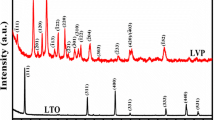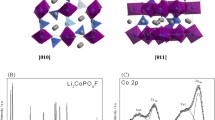Abstract
Lithium transition-metal oxides (LiTMOs) such as LiCoO2 and LiMn2O4 were investigated for their use as anode material for the lithium secondary battery. Ni¦Li0¦LiPF6(lM, EC + DEC (1 : l))¦LiTMO¦Cu cell was fabricated and its electrochemical properties were examined. LiCoO2 and LiMn2O4 showed fairly good characteristics as anode material as well as cathode material. At the 1st cathodic process, LiCoO2 had a potential plateau at 1.4 V on open circuit potential line, but LiMn2O4 had two ambiguous potential plateaus between 0.6 and 0.1 V. The specific resistance of Li¦LiCoO2 cell was 8 ohm-g, but that of Li¦LiMn{si2}O{si4} cell decreased gradually while the reaction proceeded. The specific capacities of Li¦LiCoO2 and Li¦LiMn2O4 cells at the 1st discharge were about 300 mAh/g. Capacity retention of Li¦ LiMn2O4 cell during charge-discharge cycling was higher than that of Li¦LiCoO2 cell.
Similar content being viewed by others
References
Courtney, I. A. and Dahn, J. R., “Key Factors Controlling the Reversibility of the Reaction of Lithium with SnO2 and Sn2BPO6 Glass”,J. Electrochem. Soc,144, 2943 (1997).
Dahn, J. R, Sleigh, A. K, Shi, H, Way, B. M, Weydanz, W. J, Reimers, J. N., Zhong, Q. and von Saken, U., “Carbons and Graphites as Substitutes for the Lithium Anode”, Lithium Batteries, Ed. Pistoia, G., Elsevier, New York, 1 (1994).
Doh, C. H., Moon, S. I. and Yun, M. S., “Properties of LiPF6 (PC+ EC+DEC) Electrolyte by the Variation of PC Fraction and Initial Electrochemical Properties of Carbon Anode in the Electrolyte”,J. Korean Electrochem. Soc,3, 224 (2000).
Doh, C. H., Moon, S. I., Yun, M. S. and Yum, D. H., “Initial Capacity Fading of Meso-Phase Pitch Based Carbon Fiber as Anode Material of Lithium Ion Battery”,Bull. Korean Chem. Soc,21, 169 (2000).
Doh, C. H, Moon, S. I, Yun, M. S, Jin, C. S, Jin, B. S. and Eom, S. W, “Initial Electrochemical Insertion/Desertion of Lithium into Hard Carbon”,Carbon Science,1, 36 (2000).
Doh, C. H, Moon, S. I, Yun, M. S, Park, C. I, Yum, D. H. and Yun, S. K., “Initial Charge/Discharge of LiCoO2 Composite Cathode with Various Content of Conductive Material for the Lithium Ion Battery”,J. Korean Electrochem. Soc,2, 123 (1999).
Dubois, M., Froyer, G. and Billaud, D., “Para-Sexiphenylene as a Model Compound of Poly(para-phenylene) During the Electrochemical Intercalation of Lithium and Sodium Ions in Ethylene Carbonate-Based Electrolyte,Synth. Met.,97, 217 (1998).
Idota, Y, Matsufuji, A., Maekawa, Y and Miyasaki, T., “Tin-Based Amorphous Oxide: A High-Capacity Lithium-Ion-Storage Material”,Science,276, 1395 (1997).
Idota, Y, Mishima, M., Miyaki, Y, Kubotam T., Miyasaki, T. and Miyasaka, T., “Nonaqueous Secondary Battery”, Eur. Pat EP 0,651,450, Al (1995).
Idota, Y, “Nonaqueous Secondary Battery”, US5,478,671(1995).
Poizot, P., Lamelle, S., Grugeon, S., Depont, L. and Tarascon, J.-M., “Nano-sized Transition-metal Oxides as Negative-Electrode Materials for Lithium-Ion Batteries,Nature,407, 496 (2000).
Sun, Y.-K. and Kim, D.-W., “Synthesis and Electrochemical Characterization of LiMn2O4 Cathode Materials for Lithium Polymer Batteries”,Korean J. Chem. Eng.,16, 449 (1999).
Sun, Y-K, Kim, D.-W., Jin, S.-H., Hyung, Y-E, Moon, S.-I. and Park, D.-K., “Synthesis and Cycling Behavior of LiMn2O4 Cathode Materials Prepared by Glycine-Assisted Sol-Gel Method for Lithium Secondary Batteries”,Korean J. Chem. Eng.,15, 64 (1998).
Yamabe, T, Tanaka, K., Ago, H., Yoshizawa, K. and Yata, S., “Structure and Properties of Deeply Li-Doped Polyacenic Semiconductor (PAS),Synth. Met.,86, 2411 (1997).
Author information
Authors and Affiliations
Rights and permissions
About this article
Cite this article
Doh, CH., Jin, BS., Lim, JH. et al. Electrochemical Characteristics of Lithium Transition-Metal Oxide as an Anode Material in a Lithium Secondary Battery. Korean J. Chem. Eng. 19, 749–755 (2002). https://doi.org/10.1007/BF02706963
Received:
Accepted:
Issue Date:
DOI: https://doi.org/10.1007/BF02706963




